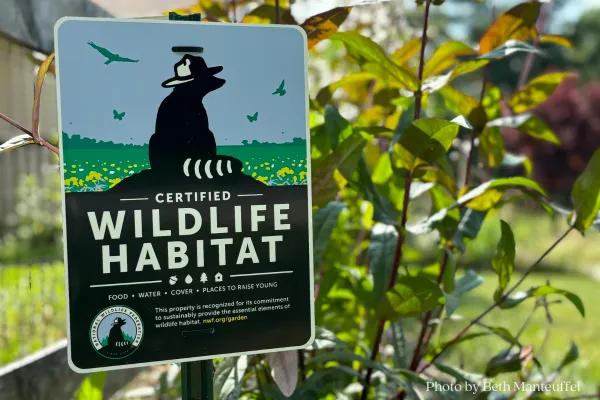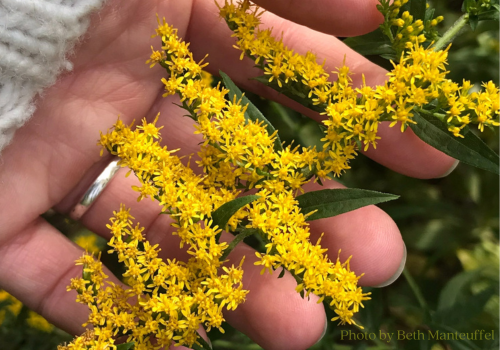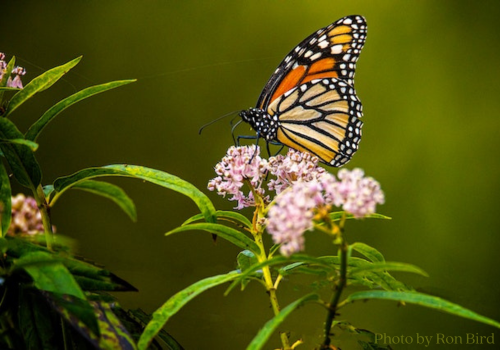Note: You may filter by category below. To use search feature for all categories return to main blog page here.

A Thriving Habitat: Creating a Garden that Supports Wildlife and Pollinators
Some of the links below are affiliate links. As an Amazon Associate I earn from qualifying purchases.
Introduction
As a nature lover, one of my favorite initiatives leading the way in wildlife conservation is the National Wildlife Federation's (NWF) Garden for Wildlife™ certification program. This program invites us to turn our outdoor spaces into sanctuaries for local wildlife and pollinators. In this blog post, we'll explore the NWF Garden for Wildlife program and ways we can create a vibrant, wildlife-friendly habitat in our own backyards, at schools, the places we work, and beyond.
The Importance of Pollinators

Before we dive into the program's details, let's take a moment to marvel at the superstars of the ecosystem: pollinators. Bees, butterflies, birds, and other pollinators play a vital role in the pollination of plants, which, in turn, leads to the production of essential fruits, vegetables, and nuts.
According to the USDA, “Three-fourths of the world’s flowering plants and about 35 percent of the world’s food crops depend on animal pollinators to reproduce. Some scientists estimate that one out of every three bites of food we eat exists because of animal pollinators like bees, butterflies and moths, birds and bats, and beetles and other insects.”
But that's not all. They also help maintain the diverse beauty of our natural world, supporting native plant species by cross-pollination and spreading seeds that ultimately provide both habitat and nourishment for other wildlife.
Despite their vital role, pollinators are currently facing some hurdles to overcome. Pesticides, habitat loss, and disease are challenging the populations of these essential creatures. To counter this and make a difference in the world, the Garden for Wildlife certification program came to be.
The Garden for Wildlife Certification Program
This certification program offers a comprehensive and easy-to-follow framework designed to help homeowners, schools, businesses, and communities create sustainable, wildlife-friendly gardens and landscapes. The program aims to turn outdoor spaces into vital habitats for wildlife, including pollinators. Here's how it works:
1. Food:
The program encourages the planting of native plants that provide nectar, seeds, berries, and insects. These plants offer a critical food source for wildlife, especially pollinators.
2. Water:
Ensuring access to clean water is essential. Gardeners are encouraged to incorporate birdbaths, rain gardens, or other water features to support wildlife. Options are available for deck-mounted bird baths if you have limited outdoor space, or if you’d like to enjoy observing birds closer to your home.
3. Cover:
Wildlife need places to hide, rest, and raise their young. This can be achieved by adding native trees, shrubs, and dense vegetation. Even the smaller creatures like toads may hide out in a small toad house. If you have a broken pot this can also be repurposed when placed upside down with an entryway.
4. Places to Raise Young:
Providing nesting spaces is an important element of the Garden for Wildlife program. This can include man-made birdhouses and established trees and shrubs.
5. Sustainable Gardening Practices:
Eliminating chemical pesticides and chemical fertilizers, conserving water, and removing invasive species are all ways to ensure a sustainable garden. See the certification checklist for requirements.
By meeting the program criteria, you can apply for and achieve NWF's Garden for Wildlife certification. Plus, you can proudly display their Certified Wildlife Habitat® sign to raise awareness in your community to have an even greater impact. This is how I first learned of the program, when on a walk with family in my childhood neighborhood. A sign in a neighbor’s yard caught our attention and makes for a great educational tool. I was excited to certify my property and display their signage to share about these initiatives in my local area. Let’s review and look at some elements from my home in the video below.
Ways to Support Pollinators in Your Garden
Now, let's explore some practical steps we can take to support pollinators right from our own gardens. It’s time to roll up our sleeves and get creative with ways to support pollinators and wildlife at home, and in our private and public spaces:
1. Choose Native Plants:
Native plants are well adapted to your region and provide essential nectar and pollen. Do some research to identify native plants that thrive in the conditions present on your property and incorporate these plants into your garden. You can also consider minimizing your lawn and replacing areas with native perennial meadows.
A great resource to find native plants that support an abundance of pollinators for your zip code is available here. This tool ranks native host plants based on the number of butterfly and moth species supported. Host plants support the next generation of caterpillars. Goldenrod (solidago) happens to be the #1 ranked host perennial flower for my area, pictured below.

2. Plant a Pollinator Garden:
Create a dedicated area in your garden for pollinators. Choose a variety of flowering plants that bloom at different times to provide a consistent food source throughout the seasons. Birds will enjoy returning to the seedheads after the bloom season.
Consider a variety of bloom types to serve a range of pollinators. For example, hummingbirds will seek tubular flowers. Some bees or butterflies will seek open, flat flowers. Others will search for umbel flowers. There are a variety of flower shapes serving different pollinators, and having multiple flower shapes in your garden will help support a diversity of those visiting your property.

3. Avoid Pesticides:
Pesticides harm both pollinators and the plants they visit. Embrace natural pest control methods and avoid using harmful chemicals in your garden. You’ll even want to be cautious with products such as vinegar, which can harm sensitive creatures like toads or salamanders that may be living in your garden. Consider it a chemical that can irritate your own skin, eyes, and lungs so be sure to protect yourself if using vinegar in the garden.
4. Provide Nesting Sites:

Birds, insects, and wildlife require different types of nesting sites depending on the species. Planting native shrubs and trees will help support future places to raise young. Birdhouses, bat boxes, and bee hotels are all great additions to support breeding and raising young. If you enjoy DIY projects, Audubon has a great guide with easy-to-build plans for safe and sturdy birdhouses. It also covers birdhouse placement for different species and birdhouse maintenance.
Deadwood is another important nesting site for certain insects, which could be strategically placed in your garden. A common home to many salamander species would be under logs, where they lay their eggs and raise young in these moist conditions.
Consider leaving standing dead trees, also known as snags, provided they do not pose a risk to life or property. If a tree must be taken down, consider leaving some of the wood on site to provide habitat. According to the National Wildlife Federation, “dead trees provide vital habitat for more than 1,000 species of wildlife nationwide.” It shared notable statistics that “by some estimates, the removal of dead material from forests can mean a loss of habitat for up to one-fifth of the animals in the ecosystem.”
5. Attract Butterflies:

Plant native perennials in your garden, fields, or deck planters. To support moths and butterflies, plant native perennials such as milkweed, coneflowers and asters, or other species native to your geographic location.
Did you know that the monarch butterfly is a specialist species, meaning that it will only lay its eggs on milkweed? The monarch caterpillar has evolved to exclusively eat milkweed (Asclepias spp.), and therefore a monarch will only utilize this plant species for its egg laying. This is such an important perennial to support future generations of the monarch butterfly. With the milkweed variety pack below, you can establish this important perennial in your pollinator garden. Consider getting familiar with other specialist species that need more support in your local area, so that you can plant their necessary host plants too.
6. Maintain a Water Source:

Consider providing a shallow dish on the ground and raised birdbaths. I like to have these available at multiple heights and depths. Placing shallow water dishes at ground level provides a safe place for toads to enter and exit, while other birdbaths provide drinking water and a bathing place for birds and wildlife. I like to find textured dishes with sloped or stepped sides to make it easier for their safe exit.
You can install rocks in a birdbath or dish to provide a surface with a good grip for birds and pollinators. Doing this can help guide bees and wasps who need to safely approach an edge, where they can drink without slipping in. Butterflies prefer to drink from damp or wet soil so that they can consume essential minerals like sodium, which are lacking in nectar. They will avoid drinking plain ole’ water. You can install a puddling dish in your garden which can be made using stones or gravel to create perches, then add a moist sand or soil mixture.
7. Create Habitat Diversity:
A mix of native flowers, trees, and shrubs in your garden will attract a diverse range of wildlife and pollinators. Consider ways to create habitat layers. For example, a tree and shrub in a field provide refuge to birds passing through. A tree or shrub near a garden offers a place for birds to take cover when they need to hide from a predator. Richard Darke and Doug Tallamy wrote a wonderful book called The Living Landscape that I really enjoyed, which goes into detail on this topic.
8. Educate and Advocate:
Share your knowledge and passion for wildlife conservation with friends, family, and neighbors. Advocate for wildlife and pollinator-friendly practices in your community. Consider purchasing the Garden for Wildlife signage when you certify your property to increase awareness in your area. I’m on a continual education journey myself, always learning from places like podcasts, Audubon lectures, and webinars.
Benefits of Your Wildlife-Friendly Garden
Supporting pollinators and wildlife in our gardens allows us to make a positive impact while enjoying the beauty of our natural world. Here are a few of the added benefits:
1. Abundant Harvest:
A pollinator-friendly garden increases the yield of fruits and vegetables in your garden by enhancing pollination.
2. Nature's Art Gallery:
Your garden transforms into a vibrant, lively ecosystem, offering aesthetic beauty of both flowers and nature's processes.
3. Soundscaping:
There’s nothing quite like the sounds of birdsong and the chorus of insects you’ll hear in a thriving habitat. The soundtracks of nature are truly the best.
4. Teaching Moments:
Involve kids and adults in your wildlife conservation efforts, creating wonderful learning opportunities for all.
5. Showcase Property:
An established pollinator garden and landscape can increase your property's value, attracting potential buyers or renters.
6. Environmental Stewardship:
By supporting pollinators and wildlife, you contribute to the larger collective effort of preserving our natural world.
Final Thoughts

The National Wildlife Federation's Garden for Wildlife certification program offers an inspiring and practical way to make a positive impact on the environment, right in our backyards and communities. By embracing this program, we’ll help these vital creatures of our planet, contribute to global sustainability initiatives, and add more beautiful life experiences to our days. It’s those little moments where we slow down and observe nature that can have such a great impact on our wellbeing and daily life.
Ready to get involved? When you join the Garden for Wildlife program, you’ll watch your garden evolve into a lively haven for pollinators and wildlife. To access the National Wildlife Federation's Garden for Wildlife certification checklist visit here. If you're interested in certifying your garden go to NWF's certification page. Your efforts will create ripples of positive change in the world, where collectively we can have widespread impact. Let’s celebrate the incredible biodiversity that surrounds us, and nurture our planet, garden by garden!
To receive future blog posts click the button above to opt-in. I also invite you to follow me on my Facebook™ business page, and in the Sustainability & Wellness Seekers Facebook™ Group, linked here. You are welcome to join the community conversations!
Copyright 2023 Beth Manteuffel All rights reserved


